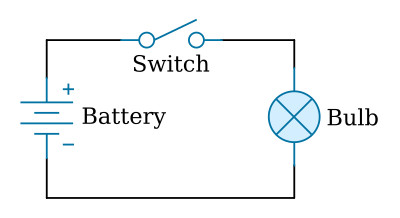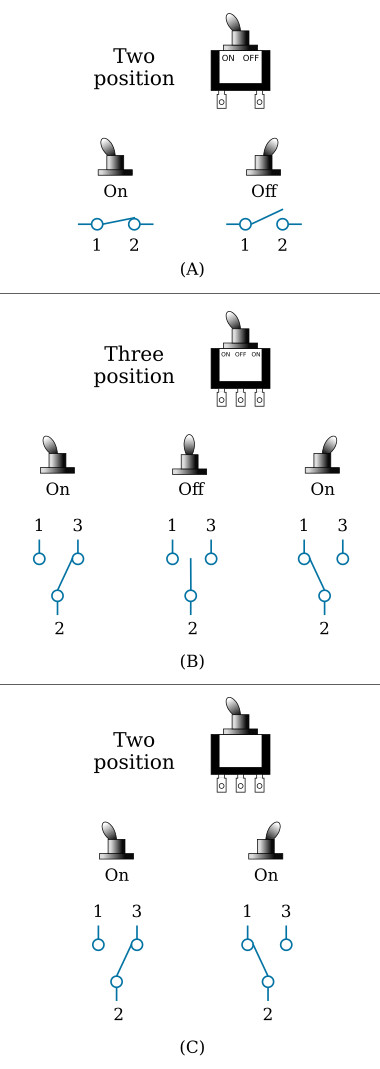Home > Textbooks > Basic Electronics > Switches > Switch Types >
Switches
Switch Types
A common switch, which is used to make and break electric connections, is the "on-off" toggle switch. Such a switch might be used in a simple circuit to turn on or off the light bulb (figure below). In this type there are two contacts, and the switch either connects them together (closed contacts) or disconnects them (open contacts), depending upon which way the handle is thrown. Neither the body of the switch nor the handle is electrically connected to either of the two contacts. Any switch that closes or opens one pair of contacts is called a single-pole, single-throw (or SPST) switch.

Number of Poles and Number of Throws
Switches are usually classified by the number of poles and number of throws. Poles are shown in schematics as those contacts through which current enters the switch; they are connected to the movable contacts. Each pole may be connected to another part of the circuit through the switch by "throwing" the switch (movable contacts) to another position. This action provides an individual conduction path through the switch for each pole connection. The number of throws indicates the number of different circuits that can be controlled by each pole. By counting the number of points where current enters the switch (from the schematic symbol or the switch itself), you can determine the number of poles. By counting the number of different points each pole can connect with, you can determine the number of throws.
The figure below will help you understand this concept by showing schematic symbols of various switches.

The figure above (view A) shows the schematic symbol of a single-pole, double-throw switch. The left connection of the schematic symbol represents the point at which current enters the switch. The right connections represent the two different points to which this current can be switched. From the schematic symbol, it is easy to determine that this is a single-pole, double-throw (SPDT) switch.
Now look at the figure above (view B). The schematic symbol has two points at which current can enter the switch, so this is a double-pole switch. Each of the poles is mechanically connected (still electrically separate) to one point, so this is a single-throw switch. Only one throw is required to route two separate circuit paths through the switch.
The figure above (view C) shows the schematic symbol of a double-pole, double-throw switch.
It might help you to think of switches with more than one pole as several switches connected together mechanically. For example, the switch shown in the figure above (view C) could be thought of as two single-pole, double-throw switches mechanically connected together.
Type of Actuator
In addition to the toggle switch already described, switches can have other actuators (moving parts). There are knife switches, pushbuttons, rocker switches, paddle switches, keyboard switches and rotary switches.
Number of Positions
Switches are also classified by the number of positions of the actuating device. The figure below shows three toggle switches, the toggle positions, and schematic diagrams of the switch. The figure below (view A) is a single-pole, single-throw, two-position switch. The switch is marked to indicate the ON position (when the switch is closed) and the OFF position (when the switch is open). The figure below (view B) is a single-pole, double-throw, three-position switch. The switch markings show two ON positions and an OFF position. When this switch is OFF, no connection is made between any of the terminals. In either of the ON positions, the center terminal (2) is connected to one of the outside terminals. (The outside terminals are not connected together in any position of the switch.) The figure below (view C) is a single-pole, double-throw, two-position switch. There is no OFF position. In either position of this switch, the center terminal (2) is connected to one of the outside terminals.

Momentary and Locked Position Switches
In some switches, one or more of the switch positions are momentary. This means that the switch will only remain in the momentary position as long as the actuator is held in that position. As soon as you let go of the actuator, the switch will return to a non-momentary position. The starter switch on an automobile is an example of a momentary switch. As soon as you release the switch, it no longer applies power to the starter.
Another type of switch can be locked in or out of some of the switch positions. This locking prevents the accidental movement of the switch. If a switch has locked-in positions, the switch cannot be moved from those positions accidentally (by the switch being bumped or mistaken for an unlocked switch). If the switch has locked-out positions, the switch cannot be moved into those positions accidentally.






